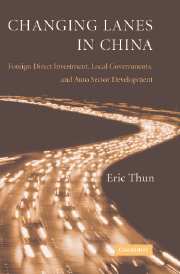Book contents
- Frontmatter
- Contents
- List of Figures and Tables
- List of Abbreviations
- Preface
- PART I INTRODUCTION
- PART II DEVELOPMENT IN A PROTECTED MARKET
- 3 Coordinating Development in the Auto Sector
- 4 Shanghai: A Local Developmental State
- 5 Beijing and Guangzhou: Laissez-Faire Local States
- 6 Changchun and Wuhan: Firm-Dominated Localities
- PART III DEEPENING GLOBAL INTEGRATION
- PART IV CONCLUSION
- Appendix on Research Methods
- Bibliography
- Index
4 - Shanghai: A Local Developmental State
Published online by Cambridge University Press: 12 November 2009
- Frontmatter
- Contents
- List of Figures and Tables
- List of Abbreviations
- Preface
- PART I INTRODUCTION
- PART II DEVELOPMENT IN A PROTECTED MARKET
- 3 Coordinating Development in the Auto Sector
- 4 Shanghai: A Local Developmental State
- 5 Beijing and Guangzhou: Laissez-Faire Local States
- 6 Changchun and Wuhan: Firm-Dominated Localities
- PART III DEEPENING GLOBAL INTEGRATION
- PART IV CONCLUSION
- Appendix on Research Methods
- Bibliography
- Index
Summary
Despite the dramatic twists and turns that have typified China's economic history during the last century, the city of Shanghai has more often than not symbolized each particular era. In 1987, writing in the party mouthpiece Hongqi, Mayor Jiang Zemin put forth the official CCP view of Shanghai history: “Before Liberation it was a microcosm of old China. It reflected in a concentrated form the major contradictions and various pathologies of the colonial, semi-colonial, and semi-feudal society. After Liberation, as the important economic centre and industrial base of our nation, its development fully manifested the vitality and superiority of the socialist system.” Three decades of rigid socialist planning removed many of the outward signs of bourgeois capitalism, but – despite official pronouncements to the contrary – also removed much of the city's former economic vitality. Losses in the state sector, which dominated industrial output and urban employment in the city, continued to rise during the 1980s; the symbol of socialist development became the symbol of socialist stagnation. Shanghai's leaders sought once again to transform the city, this time through reform and development.
Shanghai municipal leaders, like leaders in other cities, chose the auto sector as a prime candidate for development because the extensive linkages of the industry created the potential for a broad impact. These same linkages, however, increased the challenge of coordinating development in the sector.
- Type
- Chapter
- Information
- Changing Lanes in ChinaForeign Direct Investment, Local Governments, and Auto Sector Development, pp. 100 - 135Publisher: Cambridge University PressPrint publication year: 2006



